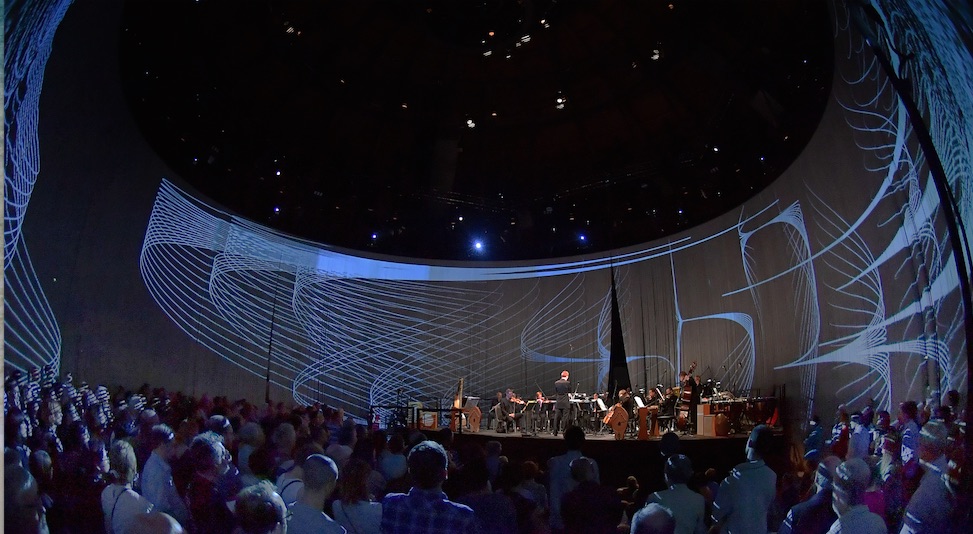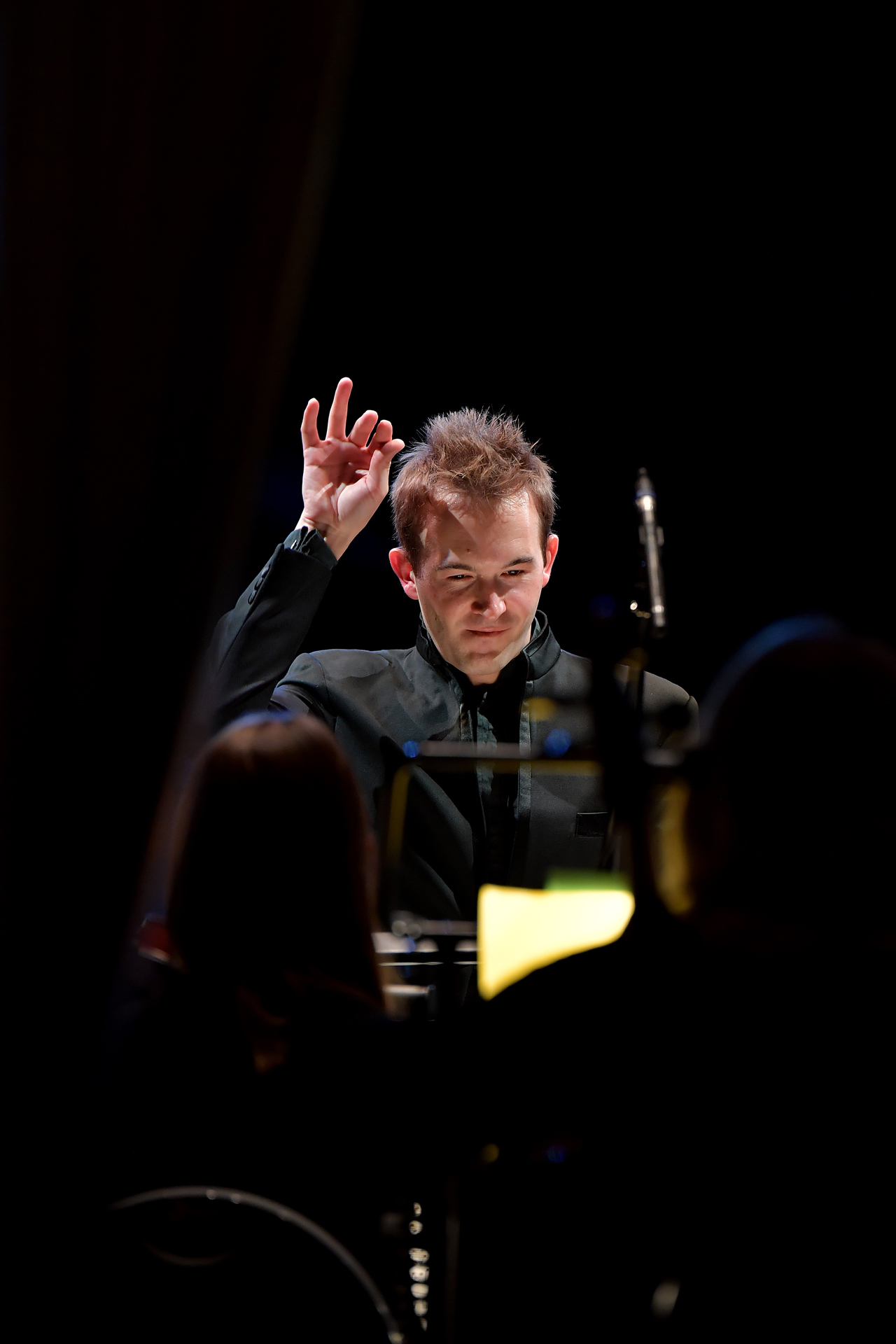Proms at Roundhouse: London Sinfonietta, Gourlay | reviews, news & interviews
Proms at...Roundhouse: London Sinfonietta, Gourlay
Proms at...Roundhouse: London Sinfonietta, Gourlay
An enchanted fusion of microtonal magic and luminous projection
Some enchanted afternoon in Camden Town… the Proms returned to the Roundhouse after four decades with a dreamlike fusion of sound, space and light. Ron Arad’s Curtain Call – a 360° installation of 5,600 sillicon rods – encircled the London Sinfonietta and audience in its luminescent embrace, a haze of microtonal music slinking through a sequence of glimmering projections.
The programme built towards György Ligeti’s Ramifications, an indelible masterpiece of the gauziest microtonal weave, and part-inspiration for Georg Friedrich Haas’s Open Spaces II (2007). In this ravishing work Haas also pays homage to composer James Tenney, bright clouds of partials skittering off two sets of cymbals and gongs, recalling Tenney’s own gong tour de force, Having never written a note for percussion. Seething light projections chimed with the metallic percussion, just as fractal-like threads picked up the wandering line of spindly strings (pictured below). Where the writhing spaghetti belonged is harder to say.

There’s an indefinable, almost tragic, grandeur to Haas’s music. Through subtly dissonant meshes, performed by two string groups in and outside the curtain playing a sixth of a tone apart, he channels a deep vein of Viennese Romanticism. Overtones of the bass’s sub-bass note generated surprisingly warm consonance, and only half-way through did I become completely aware of the friction between the two string groups, one slightly out of focus, as if at a distance. London Sinfonietta’s seasoned players realised this demanding score with exquisite skill, right up to the precise but manic trilling of its end.
Besides this, works of the younger generation felt like junior exercises in developing a single strand of Ligeti’s thinking. Mica Levi’s new piece Signal before War (2016) enacted the slow, continuous ascent of pitch up the violin from bottom to top over a three minute span. Jonathan Morton rendered it with mesmerising control, breaking the tension in a flourish of vibrato. Jonny Greenwood’s Smear (2004) plays with the lithe glissandi of two ondes martenots, which slither snake-like through a shifting orchestral texture. It’s an appealing dreamscape, in no way enhanced by images of autumn trees.

And then came the Ligeti, smelling, as he memorably said, "high, the music is starting to decompose". Here, the tuning of one string group is a quarter-tone lower than the other, creating a quivering web of 24 pitches, moving through extremes of dynamic, pulsing with interference. This was a performance of extraordinary subtlety and precision. Visuals, by SDNA Ltd, had been effective when abstract; here we had the ludicrous introduction of giant spiders. Ligeti's crawling disintegration needs no arachnid assistance.
rating
Share this article
Add comment
The future of Arts Journalism
You can stop theartsdesk.com closing!
We urgently need financing to survive. Our fundraising drive has thus far raised £49,000 but we need to reach £100,000 or we will be forced to close. Please contribute here: https://gofund.me/c3f6033d
And if you can forward this information to anyone who might assist, we’d be grateful.

Subscribe to theartsdesk.com
Thank you for continuing to read our work on theartsdesk.com. For unlimited access to every article in its entirety, including our archive of more than 15,000 pieces, we're asking for £5 per month or £40 per year. We feel it's a very good deal, and hope you do too.
To take a subscription now simply click here.
And if you're looking for that extra gift for a friend or family member, why not treat them to a theartsdesk.com gift subscription?
more Classical music
 From Historical to Hip-Hop, Classically Black Music Festival, Kings Place review - a cluster of impressive stars for the future
From quasi-Mozartian elegance to the gritty humour of a kitchen inspection
From Historical to Hip-Hop, Classically Black Music Festival, Kings Place review - a cluster of impressive stars for the future
From quasi-Mozartian elegance to the gritty humour of a kitchen inspection
 Shibe, LSO, Adès, Barbican review - gaudy and glorious new music alongside serene Sibelius
Adès’s passion makes persuasive case for the music he loves, both new and old
Shibe, LSO, Adès, Barbican review - gaudy and glorious new music alongside serene Sibelius
Adès’s passion makes persuasive case for the music he loves, both new and old
 Anja Mittermüller, Richard Fu, Wigmore Hall review - a glorious hall debut
The Austrian mezzo shines - at the age of 22
Anja Mittermüller, Richard Fu, Wigmore Hall review - a glorious hall debut
The Austrian mezzo shines - at the age of 22
 First Person: clarinettist Oliver Pashley on the new horizons of The Hermes Experiment's latest album
Compositions by members of this unusual quartet feature for the first time
First Person: clarinettist Oliver Pashley on the new horizons of The Hermes Experiment's latest album
Compositions by members of this unusual quartet feature for the first time
 Gesualdo Passione, Les Arts Florissants, Amala Dior Company, Barbican review - inspired collaboration excavates the music's humanity
At times it was like watching an anarchic religious procession
Gesualdo Passione, Les Arts Florissants, Amala Dior Company, Barbican review - inspired collaboration excavates the music's humanity
At times it was like watching an anarchic religious procession
 Classical CDs: Camels, concrete and cabaret
An influential American composer's 90th birthday box, plus British piano concertos and a father-and-son duo
Classical CDs: Camels, concrete and cabaret
An influential American composer's 90th birthday box, plus British piano concertos and a father-and-son duo
 Cockerham, Manchester Camerata, Sheen, Martin Harris Centre, Manchester review - re-enacting the dawn of modernism
Two UK premieres added to three miniatures from a seminal event of January 1914
Cockerham, Manchester Camerata, Sheen, Martin Harris Centre, Manchester review - re-enacting the dawn of modernism
Two UK premieres added to three miniatures from a seminal event of January 1914
 Kempf, Brno Philharmonic, Davies, Bridgewater Hall, Manchester review - European tradition meets American jazz
Bouncing Czechs enjoy their Gershwin and Brubeck alongside Janáček and Dvořák
Kempf, Brno Philharmonic, Davies, Bridgewater Hall, Manchester review - European tradition meets American jazz
Bouncing Czechs enjoy their Gershwin and Brubeck alongside Janáček and Dvořák
 Solomon, OAE, Butt, QEH review - daft Biblical whitewashing with great choruses
Even a top soprano and mezzo can’t make this Handel paean wholly convincing
Solomon, OAE, Butt, QEH review - daft Biblical whitewashing with great choruses
Even a top soprano and mezzo can’t make this Handel paean wholly convincing
 Two-Piano Gala, Kings Place review - shining constellations
London Piano Festival curators and illustrious friends entertain and enlighten
Two-Piano Gala, Kings Place review - shining constellations
London Piano Festival curators and illustrious friends entertain and enlighten
 Echo Vocal Ensemble, Latto, Union Chapel review - eclectic choral programme garlanded with dance
Beautiful singing at the heart of an imaginative and stylistically varied concert
Echo Vocal Ensemble, Latto, Union Chapel review - eclectic choral programme garlanded with dance
Beautiful singing at the heart of an imaginative and stylistically varied concert
 Scott, Irish Baroque Orchestra, Whelan, RIAM, Dublin review - towards a Mozart masterpiece
Characteristic joy and enlightenment from this team, but a valveless horn brings problems
Scott, Irish Baroque Orchestra, Whelan, RIAM, Dublin review - towards a Mozart masterpiece
Characteristic joy and enlightenment from this team, but a valveless horn brings problems

Comments
Thanks for a well written and
Thanks for a well written and descriptive review and photographs.
I was also lucky enough to be there to enjoy the 3 dimensional experience. Open Spaces II (2007) was an aural pin ball machine with instrumental sounds darting around the hall.
By the way I was also freaked out by the spider visual accompaniment to the final piece. The piece did not need; would have preferred something more abstract.